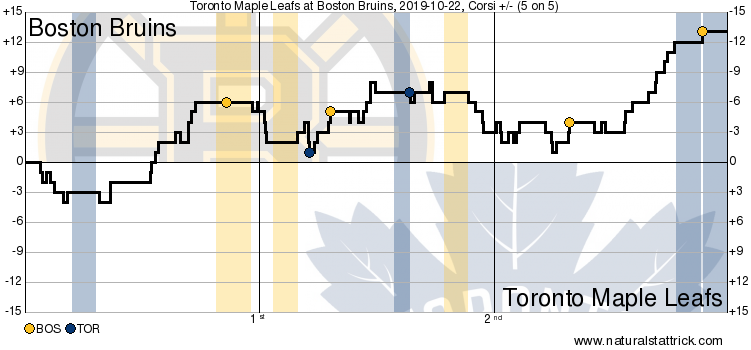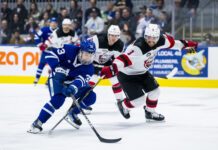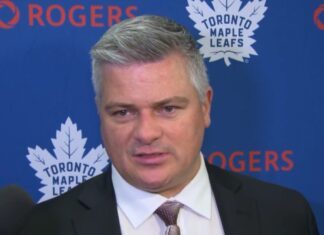The Toronto Maple Leafs hung around for 40 minutes but couldn’t see out a result in Boston on Tuesday as the tough schedule continues to test a Leafs team that is by no means firing on all cylinders yet 11 games into the year.
Your game in ten:
1. The Marner / Matthews duo at 5v5 has been clamored for incessantly among the fan base for over three years now. When asked about not playing this duo regularly last year, Babcock responded that, “he likes winning” — suggesting that the two are better apart and make the Leafs a harder team to defend against when they are hopping over the boards on consecutive shifts rather than at the same time. It appears as though Babcock may have been onto something there.
Right now, it is not working as the fan base drew it up — the two do not look good together and the numbers bear this out. Both players are pushing hard for offense, are guilty of drifting from their structure, and neither is playing with enough defensive acuity to stifle play and shut down other team’s best players. Mostly, though, it just comes down to the need for consistent, relentless second and third efforts every shift, which is currently lacking from both players without the puck. They can both be excellent defensively when there is a chance to turn a defensive strip into instant offense, but both have lacked the patience to stick with it shift-after-shift during this recent stretch.
2. The Bergeron line is still the gold standard in the league right now and it remains a matchup the Leafs don’t have the personnel to put together to combat. Hyman-Matthews-Nylander had their teeth kicked in versus the Bergeron line two playoffs ago, Hyman-Tavares-Marner survived well enough early on but waned as the series wore on last year, and so far this season, it is shaping up to be much the same story.
While Bergeron-Pastrnak can reasonably be equaled with Tavares-Marner or Matthews-Nylander, the Leafs have no one close to offering what Marchand does as a full-package, dominant three-situation player on the left wing. Naturally, you’ll always be two/thirds of a line by comparison. On top of this, though —and is still the one thing that separates them from the rest — is their ability to execute plays in crucial situations when the chips are down. They have the ruthlessness of champions (in the case of Marchand/Bergeron) and have the ability to stick with it without panicking, whether they’re trailing or holding a lead. The Leafs’ young core is going to need to develop this characteristic over time.
3. A big part of that personnel mismatch is the lack of matchup defense pairing. Babcock has said some curious things about certain defensemen in the past — namely a particular right-handed d-man now playing in Ottawa — and one comment this week about Cody Ceci sounded awfully familiar:
“He’s never in anything [scoring chances against stats]. To me, you’re doing your job. No chances against, you’re not an issue. You’re just playing good. That is a real good player.”
The truth of the matter is that this is more about the coach trying to pump up a player in the media and in the eyes of the fanbase that doesn’t really deserve it, but it’s something Babcock has done his entire time in Toronto: shield a player that needs a pick-me-up from scrutiny, pump up their tires, and hope to put the player into situations to help them succeed without outside interference impacting their play.
In the case of Ceci, he hasn’t shown the ability to play with his head above water against top competition his entire career and it isn’t any different in Toronto. The only difference here is that he is playing alongside much better offensive players and his point totals are sure to climb to new heights in that regard.
4. One idea Anthony Petrielli offered up in a recent Leafs Notebook was a change up the defense pairings by going to Rielly-Barrie as more of a second pair tasked with moving the puck up ice and playing on full offense for their shift. The coaching staff is currently without options of a trustworthy pair (Muzzin – ?) that can close out periods/games and hold leads up against the other team’s top lines. Therefore, it’s a defense-by-committee approach that aims to net out in the aggregate, although it often looks ugly on isolated shifts.
Rielly-Barrie shifts have been toyed with here and there this season and we saw a glimpse of this last night — Barrie got off a one-timer and it hit the side of the post — but there has been no extended time together yet. Muzzin was able to settle Zaitsev down in the playoffs against Boston last year to decent results, and you wonder if they will try that out at some point with Ceci, while Rielly – Barrie shifts into the above-mentioned role. No clear solutions here at the moment here, though.
5. Kasperi Kapanen hasn’t had a great start to the season, but his skating has rounded into form lately (looks to be back to jumping into holes that weren’t there for him before). Combined with playing a more forceful style, we’re starting to see signs of the Kapanen of old. Perhaps he bulked up over the summer or maybe it was simply a case of lost confidence early in the year after it didn’t go how he pictured on Tavares’ wing, but his last two games have much been closer to the player who’s able impact the game with and without the puck while using his high-end top gear to force play all over the ice. “Probably the team’s best player tonight,” as Babcock put it, would be a fair assessment.
6. Michael Hutchinson is still winless on the year and allowed another four-plus goals past him, but I thought he battled hard and hung in there as best he could. The most disconcerting part of his night was his puck handling and decision making; he needs to get away from over-handling the puck (less is more). The game looked like it could get out of a hand on a couple of occasions, but with the help of some posts and a bit of sticktoitiveness, he was able to hang in without the night getting away from him. You wonder how much is on the line this Saturday as far as his future in Toronto, though.
7. Noticed the heat map again wasn’t a pretty picture for the Leafs for the second game in a row:
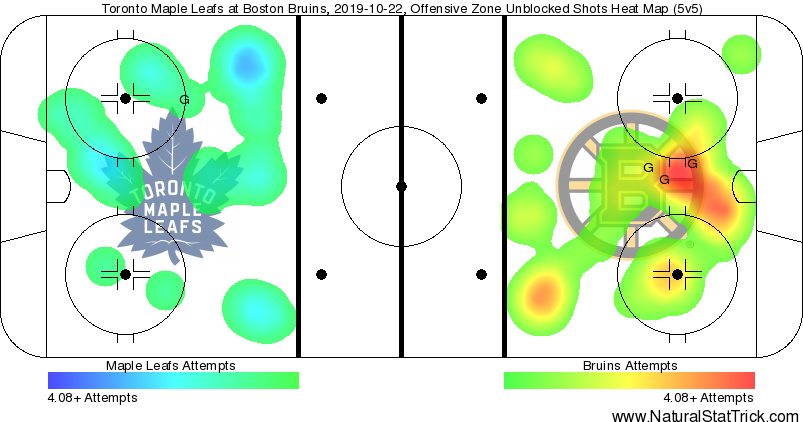
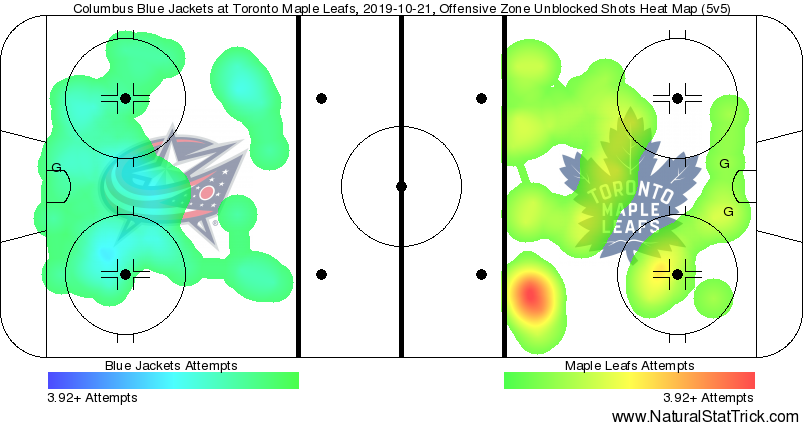
The opponents are getting direct access to the best scoring areas on the ice. The Leafs need to do a far better job of cutting the ice in half and denying access to, a) the front of the ice, and b) the other side of the zone. Not good enough.
8. It started off the other way in the first four games with the Leafs getting all sorts of calls on the soft side, but it seems to have swung strongly back in the other direction the past week, and it’s probably not surprising we saw a continuation of this in a game at TD Garden.
The Andreas Johnsson penalties were hard to stomach, but it’s not like he was losing checks and tripping because of laziness. Johnsson has turned on a real fiery side to his game that suits him well, but he’s learning how to play on the edge. It’s quite a character transformation for a player whose early scouting reports didn’t suggest this was a part of his makeup.
You don’t want to tell the player to stop playing the way he’s playing — it’s more a case of don’t get caught doing it as much while understanding the clock and the situation. Otherwise, Johnsson is looking competitive and dialled in so far this season.
9. The lack of drawn calls is probably not helped by the absence of the two players that best typify the style of play that most often draws penalties — i.e. driving the net hard — in Hyman and Tavares. The team can sulk about the lack of calls all they want, but it’s not going to change anything; the best they can do is drive the areas of the ice where penalties are most often called. The same infraction is far more likely to be called if it’s the result of a scoring play or activity in the slot/around the net than a play on the outside. You’re also usually drawing double-teams with double the chance of an infraction occurring. Keep driving the paint, keep your legs moving, take abuse, and more calls should follow.
10. All in all, as is tradition, the team coming off the back-to-back (Toronto) had a good start to the game with some residual jump in their step, but with their third game in four nights against a rested opponent, it was always going to be a tough game against a team that has had Toronto’s number for a few seasons now. Ultimately, there just wasn’t enough left in the tank in the third.
The Maple Leafs’ schedule to start the year is bizarre, to say the least, and a very tough test, but with four back-to-backs in the first month of hockey alone, it should be smoother sailing after the last back-to-back coming up with San Jose and Montreal this weekend (there will be only two in the month of November).
I don’t think we’re going to see any panic out of Dubas and company with the team at 5-4-1 — not with this schedule, the injuries they’ve had, and a PDO right now of .987 (21st in the NHL). The Leafs have to some degree overpowered poor percentages with their ability to consistently generate high levels of shot attempts and scoring chances offensively, keeping them a nose over .500 through 11 games. Panic’s not the word, but a sense of urgency should be setting in here by now.
Game Flow: 5v5 Shot Attempts
